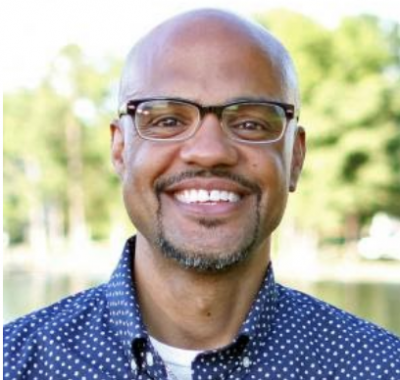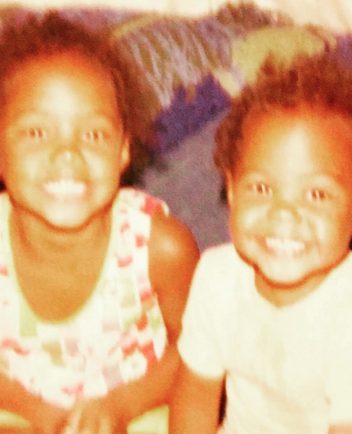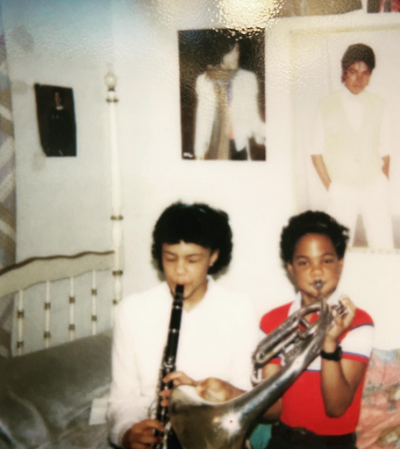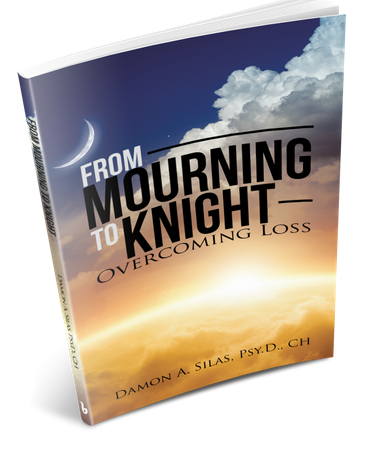The Healing Process
By Dr. Damon Silas
 How did I become so interested in trauma?
How did I become so interested in trauma?
Probably the same way most of us become attracted to certain areas of our lives, or causes near and dear to us.
Out of personal experience.
I believe that we become drawn to those things we wish to heal from in our own lives. And the same rationale applies to me.
You see, when I reflect back, I remember developing a particular penchant for trauma when I was a freshman in college. Seemingly out of the blue.
Yet, now that I look back and put the puzzle pieces together, I know exactly why.

Nikki and I cheesin'. We were close from a young age.
It was because my sister Nikki had just been murdered less than a year prior to my freshman year in college, while I was still a senior in high school.
While no one ever framed what my family and I experienced as “trauma,” I have come to learn over the years that that’s exactly what it was.
It was a sudden, unexpected loss that we had no preparation for. It was overwhelming to our systems (family and nervous systems primarily), and we had no blueprint to reference in order to help us through.
So we (my family) and more particularly, I, floated through, went through the motions, putting one foot in front of the other to simply get through day-to-day.
And that’s what we did.
Apparently I wanted to engage in self-healing, clearly unaware of doing so at the time. But by delving into the world of trauma, studying a lot of Bessel van der Kolk and his research, I was trying to get a handle of what happened to my family, what happened with my sister.
Therefore, learning became my therapy.
And then therapy became my therapy.
Because after reading the research, or perhaps even simultaneously (remembering the exact order is a little fuzzy given how long ago that was!), I started to attend both individual and group therapy at the University’s counseling center. It truly was a savior and refuge for me.
And then dance became my therapy.

Learning to play our instruments together — Nikki on the clarinet, me on my grandfather's French Horn.
After years of not dancing despite it being something I did all my life up until when my sister died, I discovered a local hip hop dance group in Washington, DC that allowed me to show up as is, in all my lack of formal dance experience-ness, in all my still-trying-to-find-myself-ness, and in all my broken-ness and simultaneously whole-ness. I began dancing with this group right after completing my doctorate in psychology.
And then community became my therapy.
This was a beautiful part of my healing process — connecting with a community of people who truly got me the way I hadn’t been gotten since, well, my sister. Not only did we dance together, we bonded on a deep level that I hadn’t experienced since the bond I had with my sister.
She and I had a special connection with each other.
Growing up approximately three years apart in age (her being older), we got along more than I did with my brother, who is more than five years older.
And even more so, given that my dad was in the military and we were constantly moving around as kids, home was where his next duty station was. It was Massachusetts, then California, then Massachusetts, then Oklahoma, then Massachusetts. And even when in those places, we weren’t necessarily in the same places or schools.
So despite the lack of external consistency we had, we had the internal consistency of family. Nikki and I in particular, because my brother was actually sent to live with my grandmother and aunt when he was in high school and I was freshly in middle school.
My sister and I laughed, created, danced, acted, sang, worked, and learned together. We became somewhat inseparable, especially after we moved back to Massachusetts from being in Oklahoma the previous six years.
We had a solid two years together of this deep and interconnected existence before she went to college at Pace University in NYC. I was jealous and excited and scared and envious and aspirational for what she was doing outside of our existence in our small town just south of Boston.
So when she was taken from us by this perpetrator, you might imagine my confusion, overwhelm, anger, sadness, and numbness.
From that point onward, I vowed to heal myself, and also help others heal. Because if I could prevent someone from taking a loved one’s life as the man who took my sister and her roommate’s lives as he had done, then I was determined to do so.
And so helping others heal became my therapy, my mission, and ultimately my purpose.
Initially it wasn’t with the understanding that my clients or patients would simultaneously help me heal. Yet it was through them I became more aware of the reciprocal nature of healing. They held up mirrors to me I didn’t know existed, and also showed me blind spots I didn’t know existed.
The healing is a continual process.

Our last Thanksgiving together with Nikki.
Yet I will say that one of the most important parts of my healing was not just through therapy, but through forgiveness.
And not just a knowing-ness of the need for such, or the verbal expression of it, e.g., “I forgive Kevin for taking my sister’s life.”
No. More like an embodiment of forgiveness. Like meeting-with-the-man-who-killed-my-sister forgiveness.
Looking him in the eye and letting him know the real impact of his decision some years later on me, on us, on our family, on Nikki’s friends, and ultimately the world.
He needed to know, and my mom and I understood the importance of doing so for ourselves.
Yet, just as therapy and my overall healing process has taught me, it wasn’t just about healing us.
It was about helping and allowing him — Kevin — as a human, as a person who made a particular decision at that time in his life — to heal as well.
Because in meeting with him on that Memorial Day weekend several years ago and many years (over 20) after his act of violence, we all gained freedom and liberation. We all dropped old chains, ways, and beliefs, and simultaneously opened up to new possibilities, new options, and new chapters.
Scratch that. We put down an old book and started a brand-new one.
So forgiveness became therapy, not just for me, but for all involved.
That is why I do this work. To witness the healing unfold in such beautiful and unexpected, yet powerful and empowering ways.
And that is why I encourage you to keep doing the work you are doing wherever you are in your process. Just when you think it’s over, it’s just beginning. And it can be scary, and frustrating, and liberating, and exciting, and unknown all at the same time.
That’s the healing of healing. It’s messy and it’s beautiful. It’s unique to you. And it’s time.
This article was inspired by Dr. Damon Silas’ book, From Mourning To Knight: Overcoming Loss.
 Dr. Damon Silas, a clinical psychologist, speaker, and teacher with 20 years of experience in the field, is the author of From Mourning To Knight: Overcoming Loss, and What’s Your ACTION Plan?: 6 Powerful Ways To Get Unstuck In Your Life Now. He is in private practice in Charlotte, North Carolina, specializing in anxiety, trauma, and working with marginalized populations.
Dr. Damon Silas, a clinical psychologist, speaker, and teacher with 20 years of experience in the field, is the author of From Mourning To Knight: Overcoming Loss, and What’s Your ACTION Plan?: 6 Powerful Ways To Get Unstuck In Your Life Now. He is in private practice in Charlotte, North Carolina, specializing in anxiety, trauma, and working with marginalized populations.
In a dynamic and creative way, Dr. Silas helps people remove their mental and emotional barriers in order to grow in all areas. Along with Alyson Stoner, he is the co-developer and co-facilitator of Mindful Movement, the holistic fitness program that reconnects mind-body-being through creativity and movement. He is also a mindful movement and hip-hop dance instructor.
Dr. Silas is the co-founder of the group Black Tappers United, a collective of Black healers whose mission is to bring the power of EFT tapping and healing to the BIPOC community. He’s featured on the Tapping Solution app, with meditations focused on racial anxiety healing, and tapping support for depression. He is certified as an EFT Intermediate Practitioner, Consulting Hypnotist, and as a mental health integrative medicine practitioner.
Catalyst is produced by The Shift Network to feature inspiring stories and provide information to help shift consciousness and take practical action. To receive Catalyst twice a month, sign up here.
This article appears in: 2021 Catalyst, Issue 10 - Transform Your Health Summit



